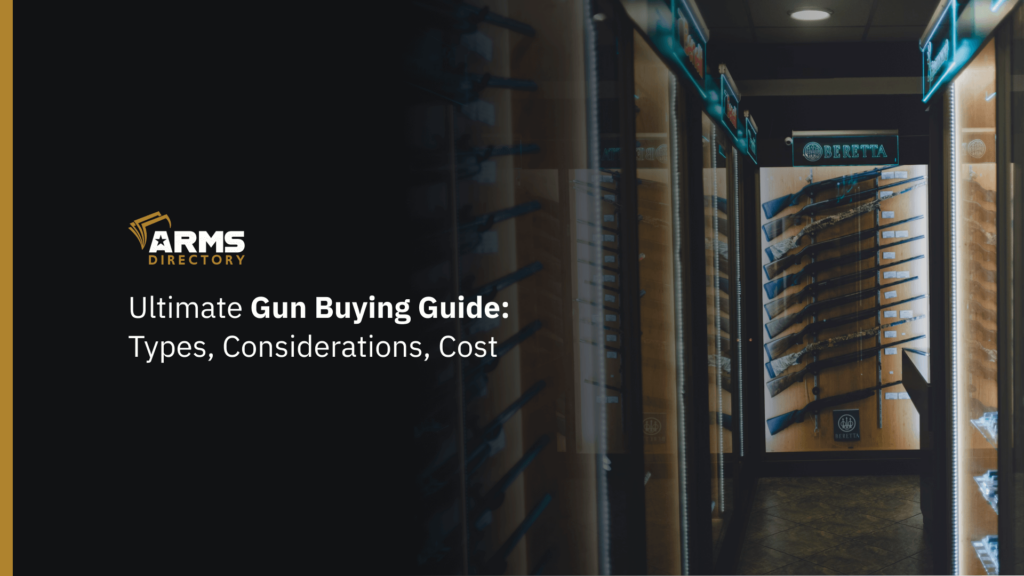
Marketing Firearms on Social Media: Dos and Don’ts
Social media is the dominant force in marketing today, as most people spend a lot of time online. There are not only sites that allow you to share content and interact with different audiences.
However, for gun business owners, establishing a brand on social media and promoting products can be a bit tough. Marketing firearms is not impossible though, and it can be pretty exciting. If you have a good social media plan, it can be highly beneficial as well as profitable, even without spending a dime on ads!
Let’s break down what you need to know about gun marketing on social media in 2024.
What Is Social Media?
Social media are all those channels that allow users to create and share content while engaging with others.
The main social media channels are:
- X (ex-Twitter)
- YouTube
- Snapchat
- TikTok
There are plenty of other, gun-friendly apps included, such as GunSpace that can be part of your social media presence.
For no reason do you, as a business, have to be present everywhere! Your social media presence depends on your goals, your target audience, and what you want to bring to the table as a content creator.
It is important to choose and then establish yourself on 2 or 3 channels because social media offers opportunities that no other marketing channel does. It gives you a wider reach and more ways to communicate and promote through content. It also enables you to create your following base to build a community around your business.

What Are the Main Challenges of Marketing Firearms on Social Media
In the digital world, there is no type of business that cannot attract polarization of opinions, as there are people ready to criticize everything. Firearm marketing on social media comes with its own challenges:
- Forget about running ads for directly selling guns: Most of the social media platforms ban firearm advertising or have applied some level of restrictions. For instance:
- Instagram: Branded content should not promote firearms (including firearms parts, ammunition, paintball guns, and BB guns).
- Facebook: You cannot promote the sale or use of weapons, ammunition, or explosives, weapon modification accessories included. However, you can run ads on gun-related content.
- Facebook Marketplace: Firearm shops and online retailers are allowed to engage in commercial activity involving offering a gun for sale as long as all applicable laws and regulations are followed.
- X: X prohibits the promotion of weapons and weapon accessories globally.
- LinkedIn: Ads related to the promotion, use, or sale of weapons, ammunition, fireworks, or any other violent product or service are prohibited
- YouTube: You cannot sell firearms or accessories on the platform.
- Snapchat: Snapchat prohibits ads for the sale of weapons, explosives, and related accessories. This includes firearms, ammunition, fireworks, combat knives, and pepper spray.
- Pinterest: The platform doesn’t allow any type of firearm advertising whether it be guns, ammunition, or accessories.
- TikTok: You cannot trade or market-regulated, prohibited, or high-risk goods and services.
- Content Policies: Social media channels change their content guidelines all the time, so it’s imperative to find creative ways to promote your businesses through content that complies with these policies. On most social media channels, you can create gun-related content, such as Second Amendment rights content, safety and firearm training, and informative content on weapons, as long as it doesn’t directly promote sales, etc.
How to Choose Social Media Channels for Your Gun Business?
Before you choose the channel you need to understand the types of content.
Short-Form Content
Short form content is flash content, such as an Instagram post or a TikTok video. It passes through the news feeds of users while scrolling. If you have really good quality content, it might live for days or sometimes months due to engagement (likes, comments, shares), but this is not always the case.
You want short content that quickly and regularly informs, entertains, or educates the people so that they will eventually become customers.
Long-Form Content
The second type of content is known as ‘evergreen content.’ It is content that offers more value to users than a post, short video, picture, or infographic. Think about a YouTube video longer than 10 minutes that goes deeper into a certain topic, such as ‘What is the best Glock?’ or ‘What is the best rifle for hunting deer?’. This is content that people might need after a month, a year, or even more.
Another good part about this type of content is that it is searchable. YouTube is also a search engine. A user can go to the search bar and type something like, ‘rifles for deer hunting,’ and voila – a video that was created years ago might pop up. It can bring traction, views, and reactions long after your Facebook post is forgotten.
In addition to YouTube, other ‘evergreen’ platforms, although not technically social media, are podcast platforms and your website’s blog. Creating such longer formats is essential to establish authority, reputation, and trust, and drive sales.
To some extent, Instagram, Facebook, and TikTok also function as search engines, especially TikTok. If your content is optimized with the keywords and phrases users might search for, and you use the right hashtags, your content might be found there too.
So, the first thing is to choose 1 or 2 fast social media and 1 or 2 ‘evergreen platforms’; let’s say Instagram and YouTube.
The choosing of the right channels depends on factors such as:
- What is your target audience? Consider who your ideal client is and create their profile, including age, demographics, and interests. If you target Gen Z and millennials, you want to be present on Instagram, TikTok, and YouTube. If your audience is other businesses, a LinkedIn presence plus a podcast might be the right formula. If your audience is Gen X or baby boomers, you cannot go without Facebook.
- Analyze the competition and draw inspiration from others: Dive into your competitors and what works best for them. The chance that it will work for you too is big. You don’t need to reinvent the wheel if something has already been proven to work. However, consider competitors of similar size to your business. While a large gun store may technically be your competitor, their social media strategy might not work for you. You can take inspiration or experiment with new ideas, but successfully copying tactics from a large brand like Glock, for instance, may not work if you’re a small business FFL seller.

How to Market Guns on Social Media
Gun businesses might be limited from directly advertising their products, but this limitation could be even advantageous. Content marketing is a well-proven and sustainable way to sell online. Building and expanding a follower base and relying on word of mouth can work better in social media marketing, and it is definitely cheaper than spending more and more money for targeted ads.
Here’s what you can do to seed success on your social media:
- Always send out responsible messages and keep safety in mind, emphasizing it in your content. Firstly, it is a transparent and decent way to communicate. Secondly, algorithms will be okay as long as you don’t put harmful messages out there.
- Create useful content: Most people use social media to discover something useful or entertaining. While you definitely don’t want to be boring and should find an entertaining element in your content, being useful and informative is more important. You can highlight product features by creating tutorials about related subjects. For example, if you want to educate people on how to buy from your online shop, you might create a video about regulations, etc. Putting your products and services in a larger context is the way to advertise them.
- Optimize your content. Even the best content is worthless if not optimized for search. Learn the basics of SEO and start applying them to each piece of content you create, even Instagram stories. Algorithms are smart and they know what you write or say, so if you use words that people search for, they will put your content in front of their eyes!
- Communicate with people: Never forget that social media networks are created to connect people and interact with others. Ask and respond to questions, encourage your followers to subscribe to your email list, request reviews and opinions, create your own Facebook groups or membership areas. Everything that stimulates people to speak and share will move the needle of the algorithms in your favor and provide you with free, priceless information about your customers.
- Collaborate with influencers: Gun influencers are one of the best ways to wave your business among larger and targeted audiences. Depending on your goals and budget, opt for micro-influencers, as they tend to have much higher engagement rates, and you need really interested people in your business to come visit, follow and buy.
- Go live and do videos: In 2024 video content is king and this won’t change anytime soon. Whether it’s short (Instagram/FB reels, TikTok videos), or longer forms (YouTube), or live sessions, people prefer to watch rather than read. Try to be funny, useful, and clear in your short videos. Be informative and authoritative in your longer ones. Organize live events to discuss hot topics and use the opportunities to promote your offers organically. This opens your business to larger audiences and builds your brand around the fact that you’re a thought leader in your field.
- Keep yourself informed about the content guidelines. You need to align with the guidelines of the social platforms you use regularly. For instance, you might want to go live to showcase a new handgun model while discussing handguns. However, you have to be aware that you don’t violate the rules, as the platform might restrict handling guns on camera. Don’t risk a ban that will ruin your handle name, potentially losing all your hard work gaining followers, or raising a red flag for your account.
How NOT to Market Guns on Social Media
It is simple:
- Don’t try to make direct sales and promotions: Due to strict policies, do not directly sell guns or ammunition through your posts.
- Avoid sharing content that could lead to heated debates or offend others.
- Refrain from using violent imagery or language as it may not only violate content guidelines but also provoke violence.
- Avoid fear-mongering: While it’s important to discuss self-defense, avoid using fear-based gun marketing tactics.
While a negative or harmful post might perform better and even become momentarily viral it can also backfire and cause damage to your brand and its reputation.
Focusing instead on creating a positive environment, educating, and building a sustainable, trustworthy brand is the key to a successful social media campaign.
Wrap Up
Social media is a powerful tool. It can help gun businesses establish themselves and build a good reputation and rapport with their customers. However marketing firearms on social media comes with a few challenges that can be overcome by being responsible, respectful of others, and informative in all your gun-related content.



![The Ultimate Shooting Accessories for Every Weapon [A 2023 Beginners Guide]](https://vault.armsdirectory.com/wp-content/uploads/2023/08/30071223/The-Ultimate-Shooting-Accessories-for-Every-Weapon-A-2023-Beginners-Guide-1024x576.png)


![The Right Way to Buy and Sell Firearms Online [Guide]](https://vault.armsdirectory.com/wp-content/uploads/2023/10/20050323/The-Right-Way-to-Buy-and-Sell-Firearms-Online-Guide-1-1024x576.png)